Analyzing Logistics & Supply Chain in Cadbury Dairy Milk Company
VerifiedAdded on 2023/06/04
|10
|2551
|156
Report
AI Summary
This report provides an analysis of Cadbury Dairy Milk's logistics management, focusing on its interface with marketing, production, and finance. It assesses the effectiveness of the company's order cycle, highlighting the steps from order placement to delivery and suggesting improvements like expanding e-commerce presence to reach remote markets. The report also examines inventory management strategies, emphasizing the importance of balancing stock levels with demand and leveraging technology for efficiency. Key findings indicate that Cadbury has a sound management system, effective distribution channels, and a strong market presence, but could further enhance its reach by adopting more inclusive strategies and reducing order cycle times. The analysis draws upon relevant theories and examples to provide a comprehensive overview of Cadbury's logistics operations and recommendations for future growth and competitiveness, this document is available on Desklib, a platform providing a wide array of study resources for students.
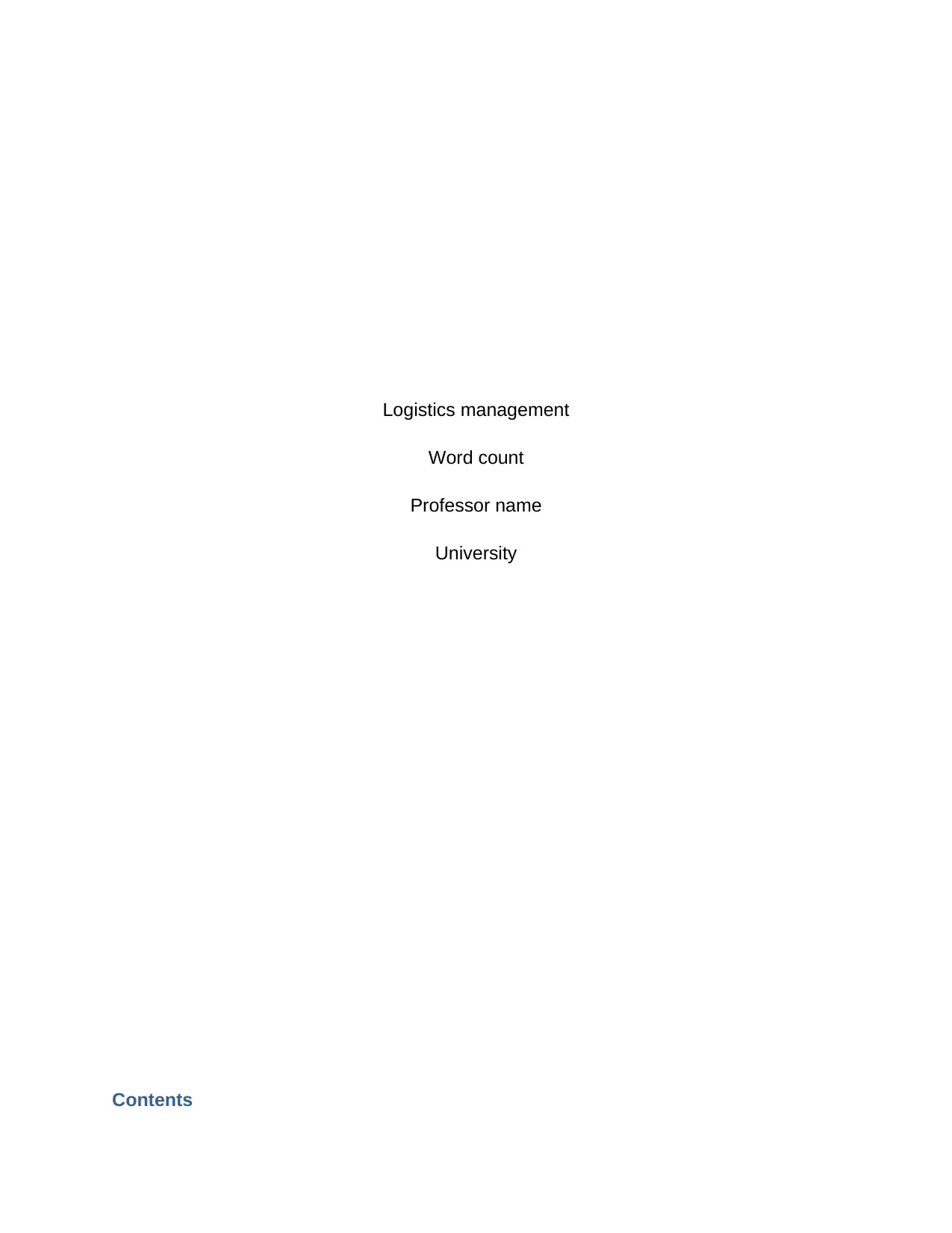
Logistics management
Word count
Professor name
University
Contents
Word count
Professor name
University
Contents
Paraphrase This Document
Need a fresh take? Get an instant paraphrase of this document with our AI Paraphraser
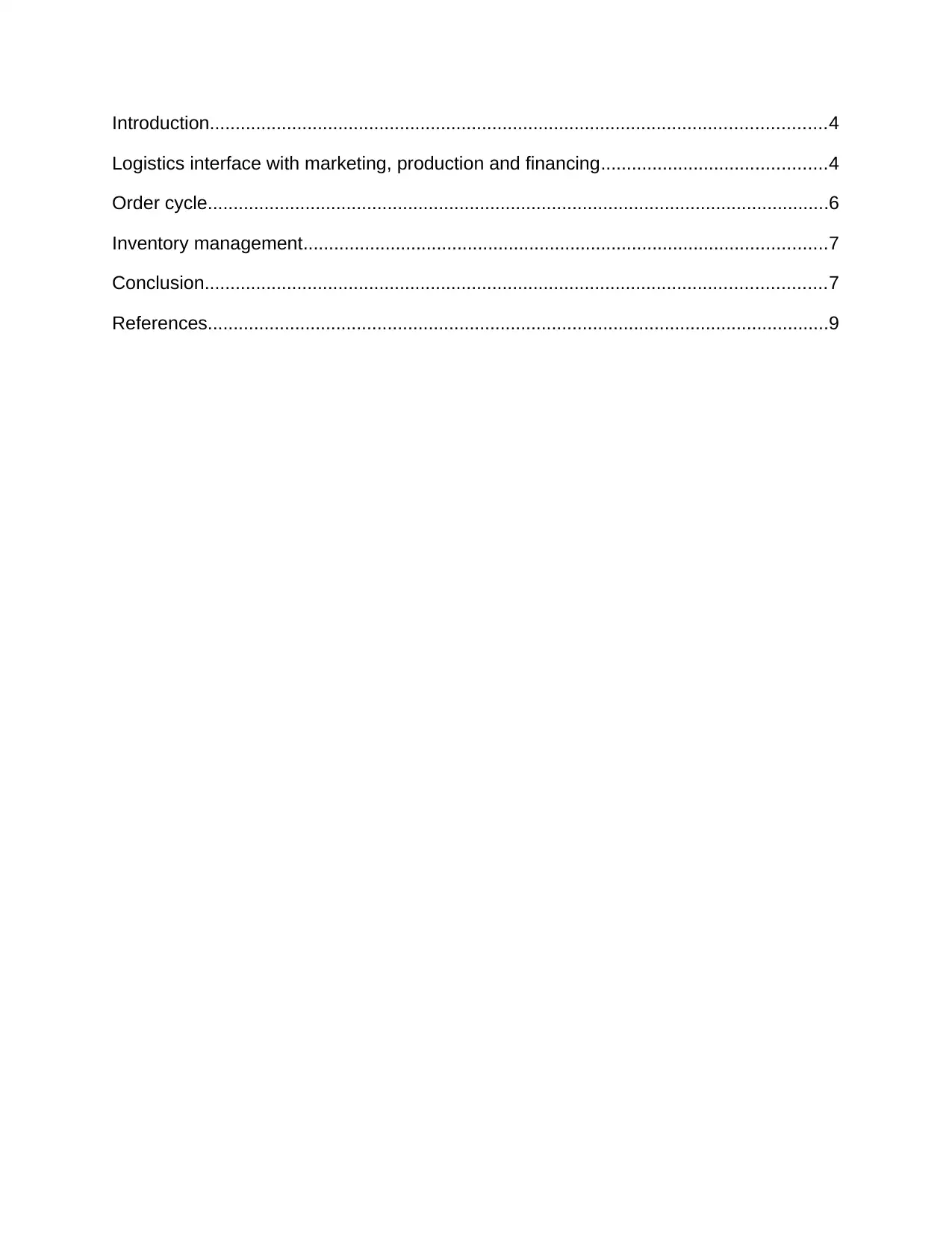
Introduction........................................................................................................................4
Logistics interface with marketing, production and financing............................................4
Order cycle.........................................................................................................................6
Inventory management......................................................................................................7
Conclusion.........................................................................................................................7
References.........................................................................................................................9
Logistics interface with marketing, production and financing............................................4
Order cycle.........................................................................................................................6
Inventory management......................................................................................................7
Conclusion.........................................................................................................................7
References.........................................................................................................................9
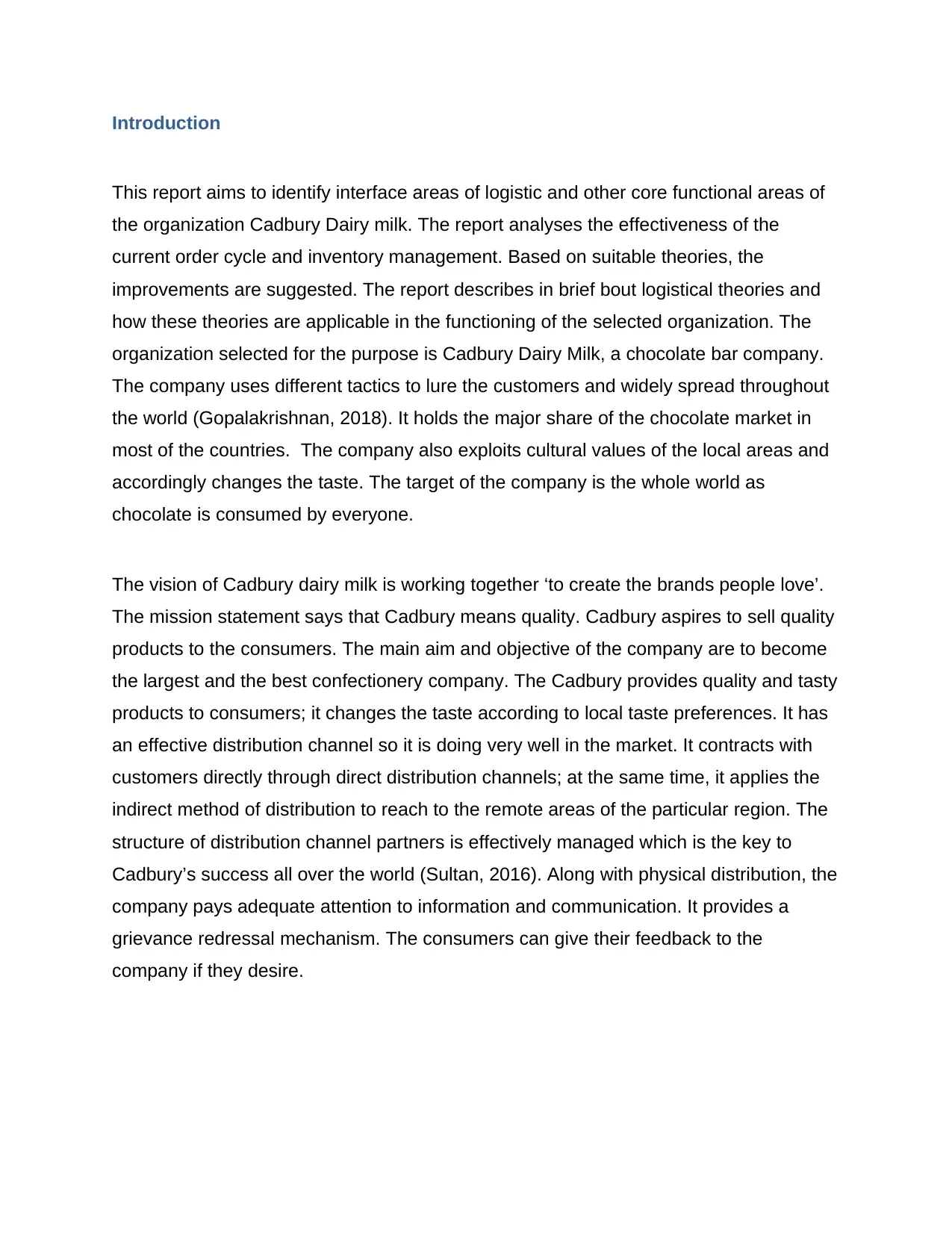
Introduction
This report aims to identify interface areas of logistic and other core functional areas of
the organization Cadbury Dairy milk. The report analyses the effectiveness of the
current order cycle and inventory management. Based on suitable theories, the
improvements are suggested. The report describes in brief bout logistical theories and
how these theories are applicable in the functioning of the selected organization. The
organization selected for the purpose is Cadbury Dairy Milk, a chocolate bar company.
The company uses different tactics to lure the customers and widely spread throughout
the world (Gopalakrishnan, 2018). It holds the major share of the chocolate market in
most of the countries. The company also exploits cultural values of the local areas and
accordingly changes the taste. The target of the company is the whole world as
chocolate is consumed by everyone.
The vision of Cadbury dairy milk is working together ‘to create the brands people love’.
The mission statement says that Cadbury means quality. Cadbury aspires to sell quality
products to the consumers. The main aim and objective of the company are to become
the largest and the best confectionery company. The Cadbury provides quality and tasty
products to consumers; it changes the taste according to local taste preferences. It has
an effective distribution channel so it is doing very well in the market. It contracts with
customers directly through direct distribution channels; at the same time, it applies the
indirect method of distribution to reach to the remote areas of the particular region. The
structure of distribution channel partners is effectively managed which is the key to
Cadbury’s success all over the world (Sultan, 2016). Along with physical distribution, the
company pays adequate attention to information and communication. It provides a
grievance redressal mechanism. The consumers can give their feedback to the
company if they desire.
This report aims to identify interface areas of logistic and other core functional areas of
the organization Cadbury Dairy milk. The report analyses the effectiveness of the
current order cycle and inventory management. Based on suitable theories, the
improvements are suggested. The report describes in brief bout logistical theories and
how these theories are applicable in the functioning of the selected organization. The
organization selected for the purpose is Cadbury Dairy Milk, a chocolate bar company.
The company uses different tactics to lure the customers and widely spread throughout
the world (Gopalakrishnan, 2018). It holds the major share of the chocolate market in
most of the countries. The company also exploits cultural values of the local areas and
accordingly changes the taste. The target of the company is the whole world as
chocolate is consumed by everyone.
The vision of Cadbury dairy milk is working together ‘to create the brands people love’.
The mission statement says that Cadbury means quality. Cadbury aspires to sell quality
products to the consumers. The main aim and objective of the company are to become
the largest and the best confectionery company. The Cadbury provides quality and tasty
products to consumers; it changes the taste according to local taste preferences. It has
an effective distribution channel so it is doing very well in the market. It contracts with
customers directly through direct distribution channels; at the same time, it applies the
indirect method of distribution to reach to the remote areas of the particular region. The
structure of distribution channel partners is effectively managed which is the key to
Cadbury’s success all over the world (Sultan, 2016). Along with physical distribution, the
company pays adequate attention to information and communication. It provides a
grievance redressal mechanism. The consumers can give their feedback to the
company if they desire.
⊘ This is a preview!⊘
Do you want full access?
Subscribe today to unlock all pages.

Trusted by 1+ million students worldwide
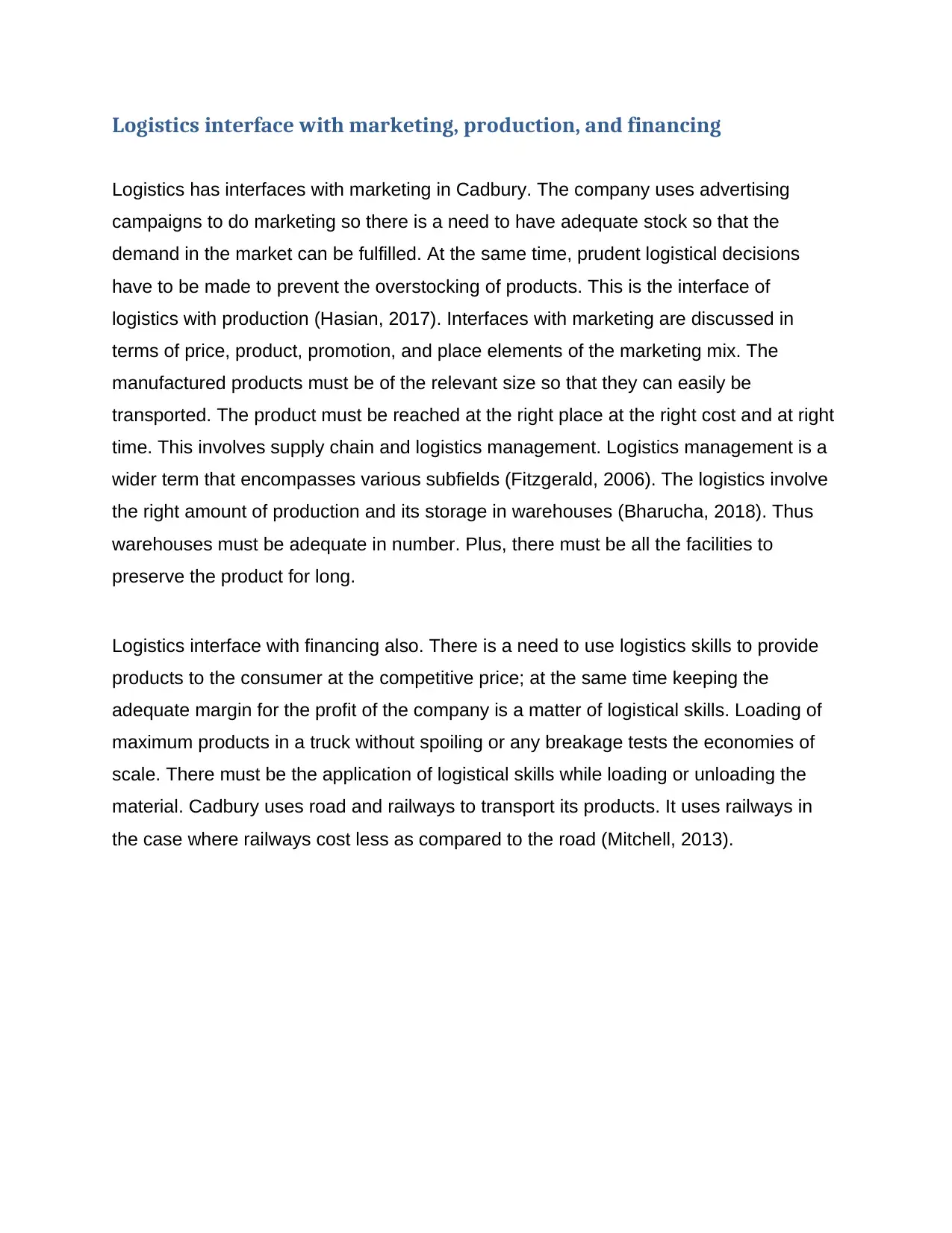
Logistics interface with marketing, production, and financing
Logistics has interfaces with marketing in Cadbury. The company uses advertising
campaigns to do marketing so there is a need to have adequate stock so that the
demand in the market can be fulfilled. At the same time, prudent logistical decisions
have to be made to prevent the overstocking of products. This is the interface of
logistics with production (Hasian, 2017). Interfaces with marketing are discussed in
terms of price, product, promotion, and place elements of the marketing mix. The
manufactured products must be of the relevant size so that they can easily be
transported. The product must be reached at the right place at the right cost and at right
time. This involves supply chain and logistics management. Logistics management is a
wider term that encompasses various subfields (Fitzgerald, 2006). The logistics involve
the right amount of production and its storage in warehouses (Bharucha, 2018). Thus
warehouses must be adequate in number. Plus, there must be all the facilities to
preserve the product for long.
Logistics interface with financing also. There is a need to use logistics skills to provide
products to the consumer at the competitive price; at the same time keeping the
adequate margin for the profit of the company is a matter of logistical skills. Loading of
maximum products in a truck without spoiling or any breakage tests the economies of
scale. There must be the application of logistical skills while loading or unloading the
material. Cadbury uses road and railways to transport its products. It uses railways in
the case where railways cost less as compared to the road (Mitchell, 2013).
Logistics has interfaces with marketing in Cadbury. The company uses advertising
campaigns to do marketing so there is a need to have adequate stock so that the
demand in the market can be fulfilled. At the same time, prudent logistical decisions
have to be made to prevent the overstocking of products. This is the interface of
logistics with production (Hasian, 2017). Interfaces with marketing are discussed in
terms of price, product, promotion, and place elements of the marketing mix. The
manufactured products must be of the relevant size so that they can easily be
transported. The product must be reached at the right place at the right cost and at right
time. This involves supply chain and logistics management. Logistics management is a
wider term that encompasses various subfields (Fitzgerald, 2006). The logistics involve
the right amount of production and its storage in warehouses (Bharucha, 2018). Thus
warehouses must be adequate in number. Plus, there must be all the facilities to
preserve the product for long.
Logistics interface with financing also. There is a need to use logistics skills to provide
products to the consumer at the competitive price; at the same time keeping the
adequate margin for the profit of the company is a matter of logistical skills. Loading of
maximum products in a truck without spoiling or any breakage tests the economies of
scale. There must be the application of logistical skills while loading or unloading the
material. Cadbury uses road and railways to transport its products. It uses railways in
the case where railways cost less as compared to the road (Mitchell, 2013).
Paraphrase This Document
Need a fresh take? Get an instant paraphrase of this document with our AI Paraphraser
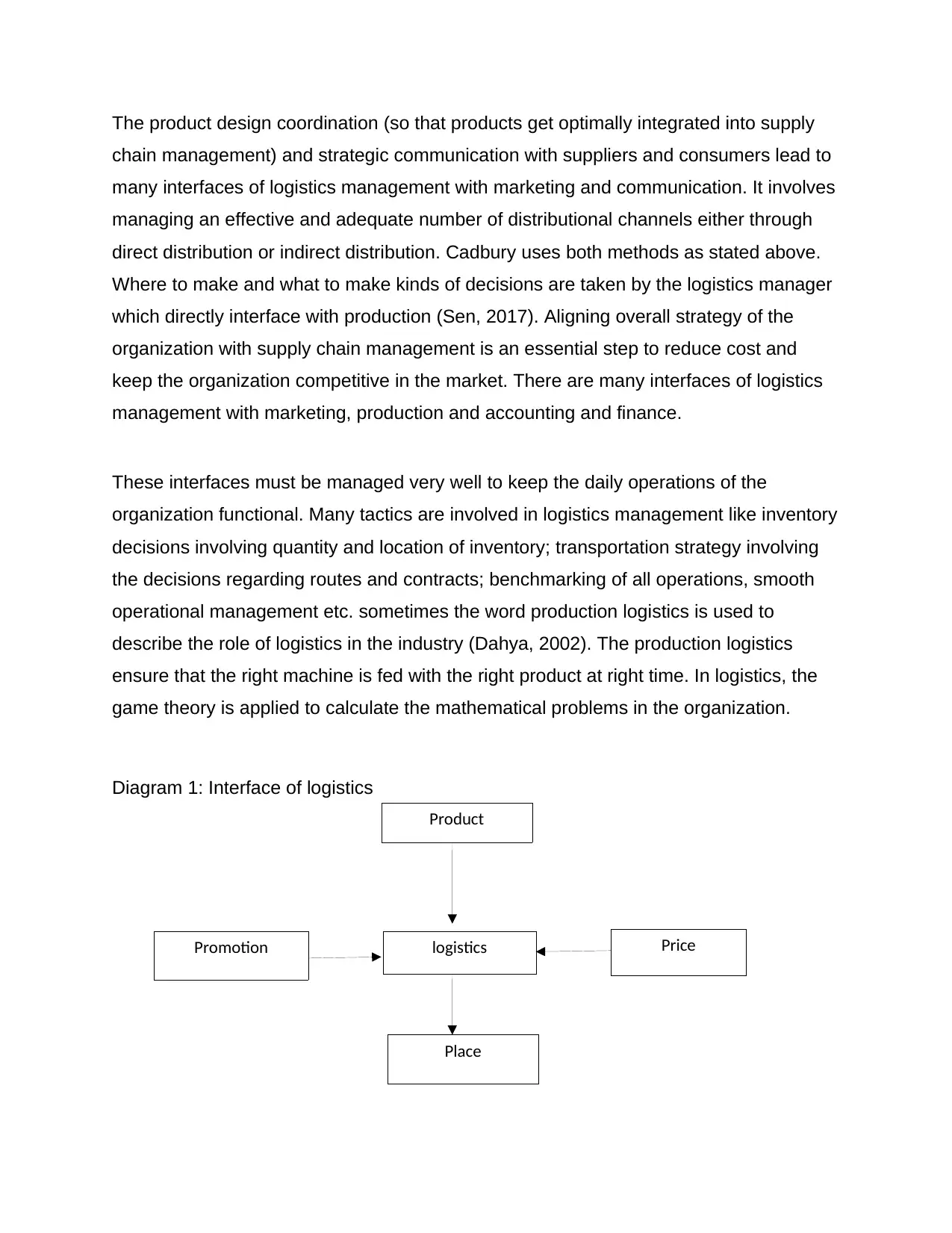
The product design coordination (so that products get optimally integrated into supply
chain management) and strategic communication with suppliers and consumers lead to
many interfaces of logistics management with marketing and communication. It involves
managing an effective and adequate number of distributional channels either through
direct distribution or indirect distribution. Cadbury uses both methods as stated above.
Where to make and what to make kinds of decisions are taken by the logistics manager
which directly interface with production (Sen, 2017). Aligning overall strategy of the
organization with supply chain management is an essential step to reduce cost and
keep the organization competitive in the market. There are many interfaces of logistics
management with marketing, production and accounting and finance.
These interfaces must be managed very well to keep the daily operations of the
organization functional. Many tactics are involved in logistics management like inventory
decisions involving quantity and location of inventory; transportation strategy involving
the decisions regarding routes and contracts; benchmarking of all operations, smooth
operational management etc. sometimes the word production logistics is used to
describe the role of logistics in the industry (Dahya, 2002). The production logistics
ensure that the right machine is fed with the right product at right time. In logistics, the
game theory is applied to calculate the mathematical problems in the organization.
Diagram 1: Interface of logistics
Product
Promotion Price
Place
logistics
chain management) and strategic communication with suppliers and consumers lead to
many interfaces of logistics management with marketing and communication. It involves
managing an effective and adequate number of distributional channels either through
direct distribution or indirect distribution. Cadbury uses both methods as stated above.
Where to make and what to make kinds of decisions are taken by the logistics manager
which directly interface with production (Sen, 2017). Aligning overall strategy of the
organization with supply chain management is an essential step to reduce cost and
keep the organization competitive in the market. There are many interfaces of logistics
management with marketing, production and accounting and finance.
These interfaces must be managed very well to keep the daily operations of the
organization functional. Many tactics are involved in logistics management like inventory
decisions involving quantity and location of inventory; transportation strategy involving
the decisions regarding routes and contracts; benchmarking of all operations, smooth
operational management etc. sometimes the word production logistics is used to
describe the role of logistics in the industry (Dahya, 2002). The production logistics
ensure that the right machine is fed with the right product at right time. In logistics, the
game theory is applied to calculate the mathematical problems in the organization.
Diagram 1: Interface of logistics
Product
Promotion Price
Place
logistics
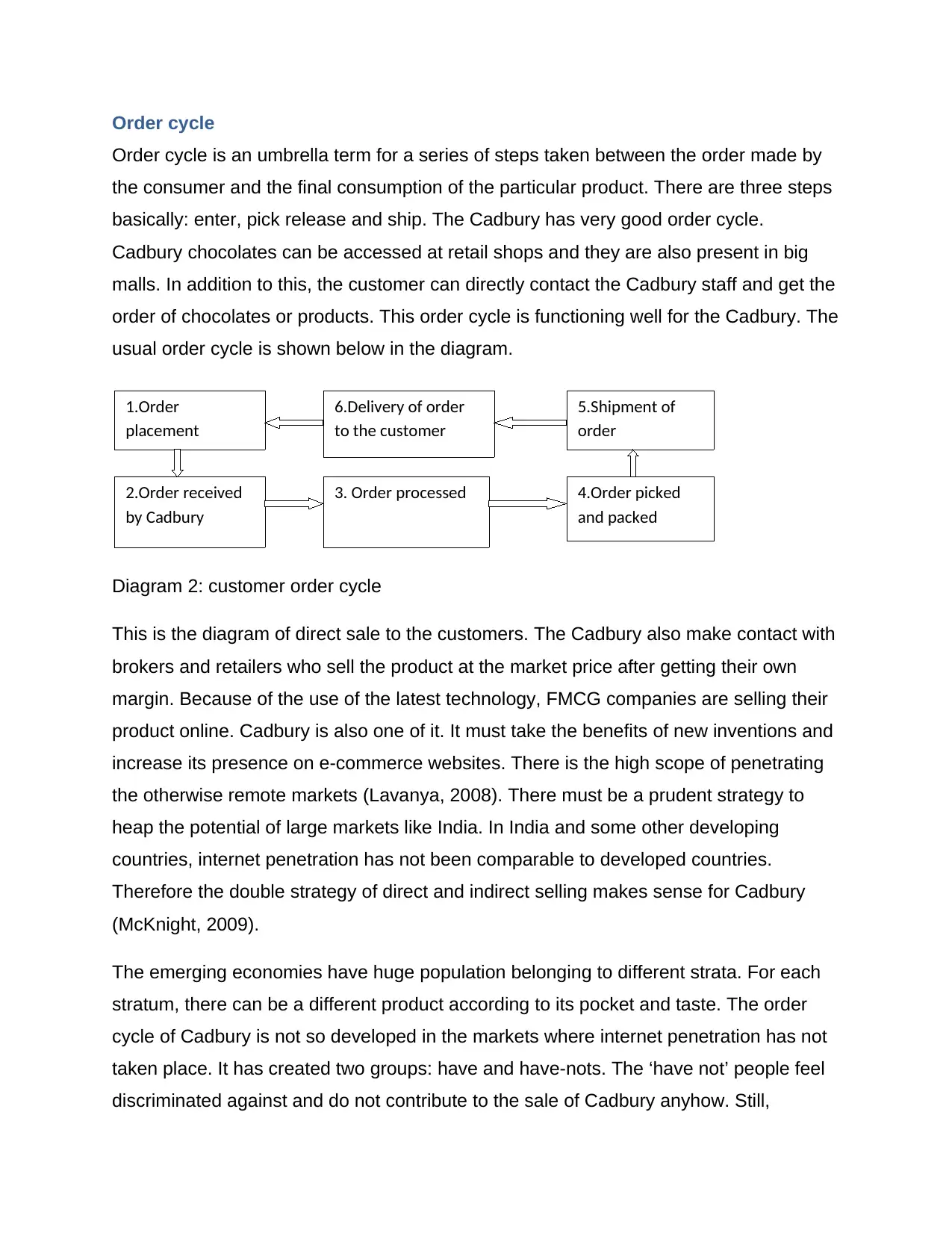
Order cycle
Order cycle is an umbrella term for a series of steps taken between the order made by
the consumer and the final consumption of the particular product. There are three steps
basically: enter, pick release and ship. The Cadbury has very good order cycle.
Cadbury chocolates can be accessed at retail shops and they are also present in big
malls. In addition to this, the customer can directly contact the Cadbury staff and get the
order of chocolates or products. This order cycle is functioning well for the Cadbury. The
usual order cycle is shown below in the diagram.
Diagram 2: customer order cycle
This is the diagram of direct sale to the customers. The Cadbury also make contact with
brokers and retailers who sell the product at the market price after getting their own
margin. Because of the use of the latest technology, FMCG companies are selling their
product online. Cadbury is also one of it. It must take the benefits of new inventions and
increase its presence on e-commerce websites. There is the high scope of penetrating
the otherwise remote markets (Lavanya, 2008). There must be a prudent strategy to
heap the potential of large markets like India. In India and some other developing
countries, internet penetration has not been comparable to developed countries.
Therefore the double strategy of direct and indirect selling makes sense for Cadbury
(McKnight, 2009).
The emerging economies have huge population belonging to different strata. For each
stratum, there can be a different product according to its pocket and taste. The order
cycle of Cadbury is not so developed in the markets where internet penetration has not
taken place. It has created two groups: have and have-nots. The ‘have not’ people feel
discriminated against and do not contribute to the sale of Cadbury anyhow. Still,
1.Order
placement
2.Order received
by Cadbury
6.Delivery of order
to the customer
5.Shipment of
order
3. Order processed 4.Order picked
and packed
Order cycle is an umbrella term for a series of steps taken between the order made by
the consumer and the final consumption of the particular product. There are three steps
basically: enter, pick release and ship. The Cadbury has very good order cycle.
Cadbury chocolates can be accessed at retail shops and they are also present in big
malls. In addition to this, the customer can directly contact the Cadbury staff and get the
order of chocolates or products. This order cycle is functioning well for the Cadbury. The
usual order cycle is shown below in the diagram.
Diagram 2: customer order cycle
This is the diagram of direct sale to the customers. The Cadbury also make contact with
brokers and retailers who sell the product at the market price after getting their own
margin. Because of the use of the latest technology, FMCG companies are selling their
product online. Cadbury is also one of it. It must take the benefits of new inventions and
increase its presence on e-commerce websites. There is the high scope of penetrating
the otherwise remote markets (Lavanya, 2008). There must be a prudent strategy to
heap the potential of large markets like India. In India and some other developing
countries, internet penetration has not been comparable to developed countries.
Therefore the double strategy of direct and indirect selling makes sense for Cadbury
(McKnight, 2009).
The emerging economies have huge population belonging to different strata. For each
stratum, there can be a different product according to its pocket and taste. The order
cycle of Cadbury is not so developed in the markets where internet penetration has not
taken place. It has created two groups: have and have-nots. The ‘have not’ people feel
discriminated against and do not contribute to the sale of Cadbury anyhow. Still,
1.Order
placement
2.Order received
by Cadbury
6.Delivery of order
to the customer
5.Shipment of
order
3. Order processed 4.Order picked
and packed
⊘ This is a preview!⊘
Do you want full access?
Subscribe today to unlock all pages.

Trusted by 1+ million students worldwide
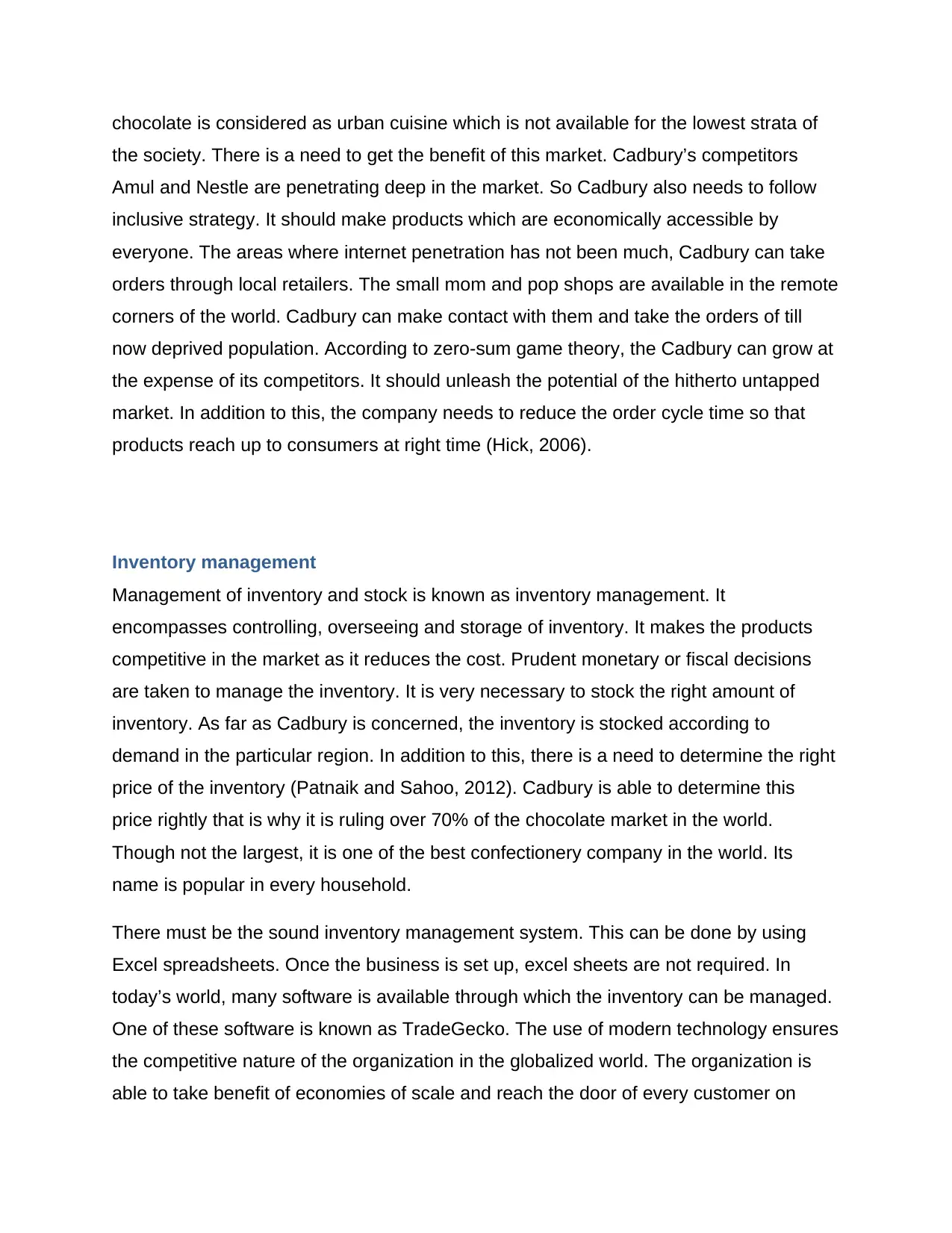
chocolate is considered as urban cuisine which is not available for the lowest strata of
the society. There is a need to get the benefit of this market. Cadbury’s competitors
Amul and Nestle are penetrating deep in the market. So Cadbury also needs to follow
inclusive strategy. It should make products which are economically accessible by
everyone. The areas where internet penetration has not been much, Cadbury can take
orders through local retailers. The small mom and pop shops are available in the remote
corners of the world. Cadbury can make contact with them and take the orders of till
now deprived population. According to zero-sum game theory, the Cadbury can grow at
the expense of its competitors. It should unleash the potential of the hitherto untapped
market. In addition to this, the company needs to reduce the order cycle time so that
products reach up to consumers at right time (Hick, 2006).
Inventory management
Management of inventory and stock is known as inventory management. It
encompasses controlling, overseeing and storage of inventory. It makes the products
competitive in the market as it reduces the cost. Prudent monetary or fiscal decisions
are taken to manage the inventory. It is very necessary to stock the right amount of
inventory. As far as Cadbury is concerned, the inventory is stocked according to
demand in the particular region. In addition to this, there is a need to determine the right
price of the inventory (Patnaik and Sahoo, 2012). Cadbury is able to determine this
price rightly that is why it is ruling over 70% of the chocolate market in the world.
Though not the largest, it is one of the best confectionery company in the world. Its
name is popular in every household.
There must be the sound inventory management system. This can be done by using
Excel spreadsheets. Once the business is set up, excel sheets are not required. In
today’s world, many software is available through which the inventory can be managed.
One of these software is known as TradeGecko. The use of modern technology ensures
the competitive nature of the organization in the globalized world. The organization is
able to take benefit of economies of scale and reach the door of every customer on
the society. There is a need to get the benefit of this market. Cadbury’s competitors
Amul and Nestle are penetrating deep in the market. So Cadbury also needs to follow
inclusive strategy. It should make products which are economically accessible by
everyone. The areas where internet penetration has not been much, Cadbury can take
orders through local retailers. The small mom and pop shops are available in the remote
corners of the world. Cadbury can make contact with them and take the orders of till
now deprived population. According to zero-sum game theory, the Cadbury can grow at
the expense of its competitors. It should unleash the potential of the hitherto untapped
market. In addition to this, the company needs to reduce the order cycle time so that
products reach up to consumers at right time (Hick, 2006).
Inventory management
Management of inventory and stock is known as inventory management. It
encompasses controlling, overseeing and storage of inventory. It makes the products
competitive in the market as it reduces the cost. Prudent monetary or fiscal decisions
are taken to manage the inventory. It is very necessary to stock the right amount of
inventory. As far as Cadbury is concerned, the inventory is stocked according to
demand in the particular region. In addition to this, there is a need to determine the right
price of the inventory (Patnaik and Sahoo, 2012). Cadbury is able to determine this
price rightly that is why it is ruling over 70% of the chocolate market in the world.
Though not the largest, it is one of the best confectionery company in the world. Its
name is popular in every household.
There must be the sound inventory management system. This can be done by using
Excel spreadsheets. Once the business is set up, excel sheets are not required. In
today’s world, many software is available through which the inventory can be managed.
One of these software is known as TradeGecko. The use of modern technology ensures
the competitive nature of the organization in the globalized world. The organization is
able to take benefit of economies of scale and reach the door of every customer on
Paraphrase This Document
Need a fresh take? Get an instant paraphrase of this document with our AI Paraphraser
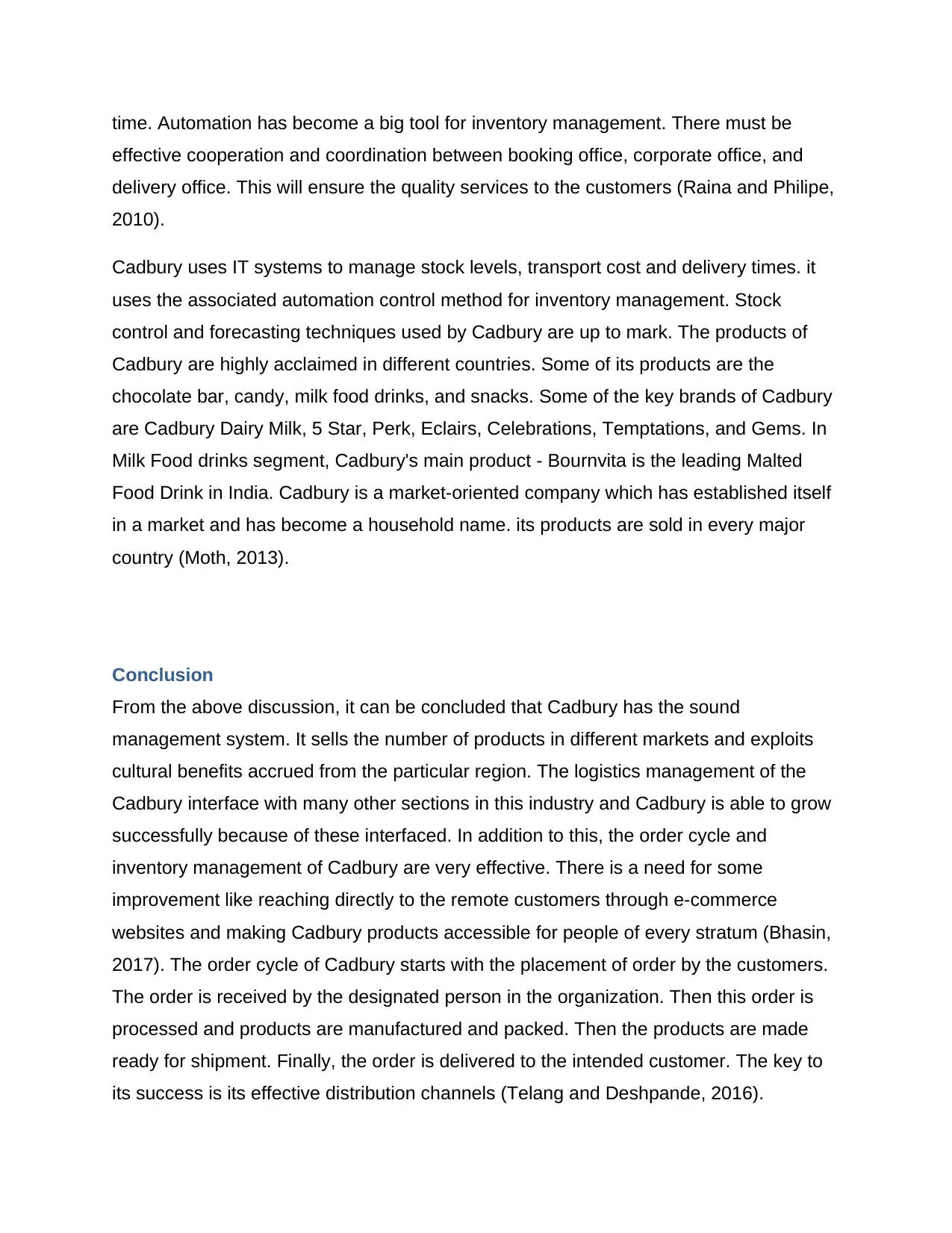
time. Automation has become a big tool for inventory management. There must be
effective cooperation and coordination between booking office, corporate office, and
delivery office. This will ensure the quality services to the customers (Raina and Philipe,
2010).
Cadbury uses IT systems to manage stock levels, transport cost and delivery times. it
uses the associated automation control method for inventory management. Stock
control and forecasting techniques used by Cadbury are up to mark. The products of
Cadbury are highly acclaimed in different countries. Some of its products are the
chocolate bar, candy, milk food drinks, and snacks. Some of the key brands of Cadbury
are Cadbury Dairy Milk, 5 Star, Perk, Eclairs, Celebrations, Temptations, and Gems. In
Milk Food drinks segment, Cadbury's main product - Bournvita is the leading Malted
Food Drink in India. Cadbury is a market-oriented company which has established itself
in a market and has become a household name. its products are sold in every major
country (Moth, 2013).
Conclusion
From the above discussion, it can be concluded that Cadbury has the sound
management system. It sells the number of products in different markets and exploits
cultural benefits accrued from the particular region. The logistics management of the
Cadbury interface with many other sections in this industry and Cadbury is able to grow
successfully because of these interfaced. In addition to this, the order cycle and
inventory management of Cadbury are very effective. There is a need for some
improvement like reaching directly to the remote customers through e-commerce
websites and making Cadbury products accessible for people of every stratum (Bhasin,
2017). The order cycle of Cadbury starts with the placement of order by the customers.
The order is received by the designated person in the organization. Then this order is
processed and products are manufactured and packed. Then the products are made
ready for shipment. Finally, the order is delivered to the intended customer. The key to
its success is its effective distribution channels (Telang and Deshpande, 2016).
effective cooperation and coordination between booking office, corporate office, and
delivery office. This will ensure the quality services to the customers (Raina and Philipe,
2010).
Cadbury uses IT systems to manage stock levels, transport cost and delivery times. it
uses the associated automation control method for inventory management. Stock
control and forecasting techniques used by Cadbury are up to mark. The products of
Cadbury are highly acclaimed in different countries. Some of its products are the
chocolate bar, candy, milk food drinks, and snacks. Some of the key brands of Cadbury
are Cadbury Dairy Milk, 5 Star, Perk, Eclairs, Celebrations, Temptations, and Gems. In
Milk Food drinks segment, Cadbury's main product - Bournvita is the leading Malted
Food Drink in India. Cadbury is a market-oriented company which has established itself
in a market and has become a household name. its products are sold in every major
country (Moth, 2013).
Conclusion
From the above discussion, it can be concluded that Cadbury has the sound
management system. It sells the number of products in different markets and exploits
cultural benefits accrued from the particular region. The logistics management of the
Cadbury interface with many other sections in this industry and Cadbury is able to grow
successfully because of these interfaced. In addition to this, the order cycle and
inventory management of Cadbury are very effective. There is a need for some
improvement like reaching directly to the remote customers through e-commerce
websites and making Cadbury products accessible for people of every stratum (Bhasin,
2017). The order cycle of Cadbury starts with the placement of order by the customers.
The order is received by the designated person in the organization. Then this order is
processed and products are manufactured and packed. Then the products are made
ready for shipment. Finally, the order is delivered to the intended customer. The key to
its success is its effective distribution channels (Telang and Deshpande, 2016).
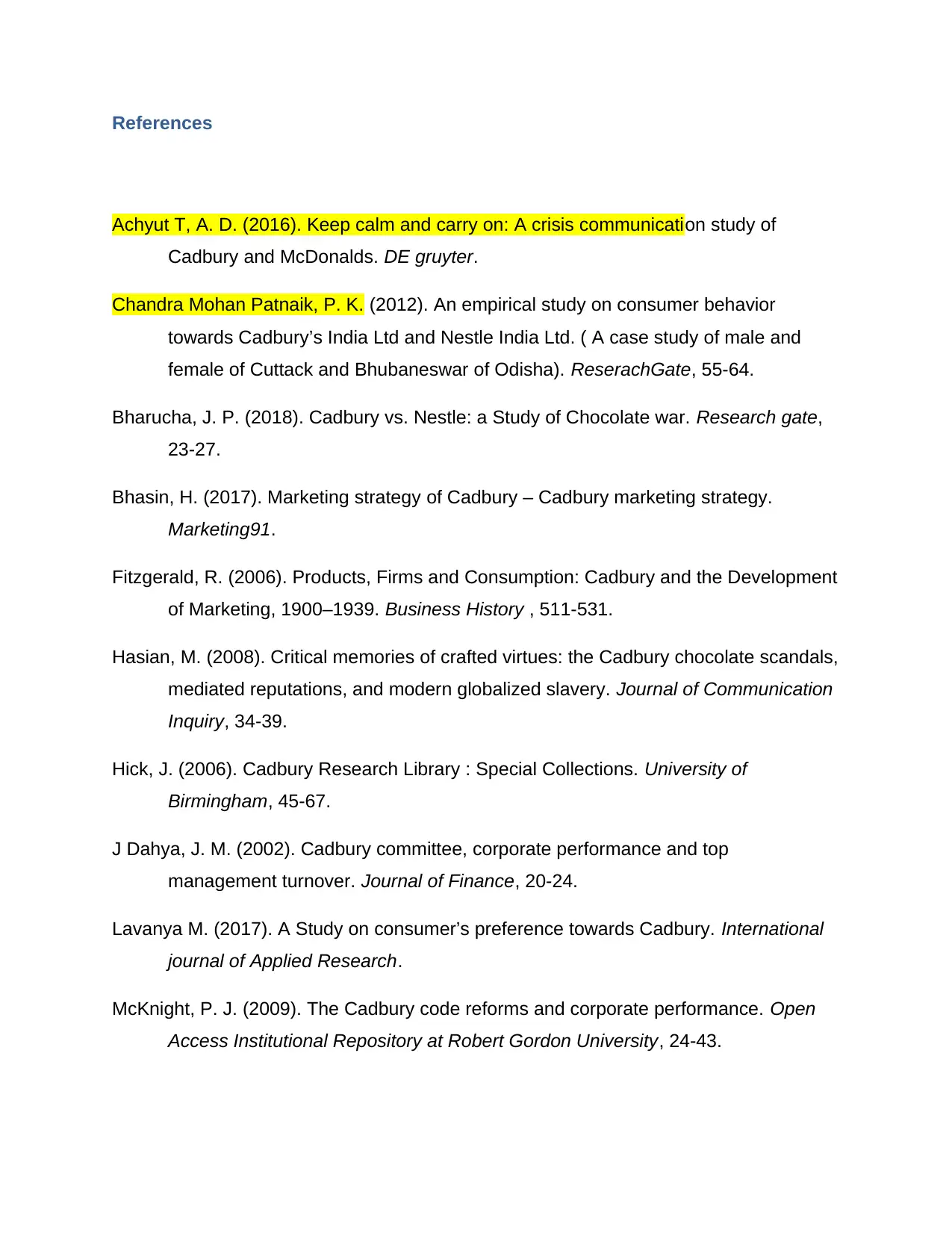
References
Achyut T, A. D. (2016). Keep calm and carry on: A crisis communication study of
Cadbury and McDonalds. DE gruyter.
Chandra Mohan Patnaik, P. K. (2012). An empirical study on consumer behavior
towards Cadbury’s India Ltd and Nestle India Ltd. ( A case study of male and
female of Cuttack and Bhubaneswar of Odisha). ReserachGate, 55-64.
Bharucha, J. P. (2018). Cadbury vs. Nestle: a Study of Chocolate war. Research gate,
23-27.
Bhasin, H. (2017). Marketing strategy of Cadbury – Cadbury marketing strategy.
Marketing91.
Fitzgerald, R. (2006). Products, Firms and Consumption: Cadbury and the Development
of Marketing, 1900–1939. Business History , 511-531.
Hasian, M. (2008). Critical memories of crafted virtues: the Cadbury chocolate scandals,
mediated reputations, and modern globalized slavery. Journal of Communication
Inquiry, 34-39.
Hick, J. (2006). Cadbury Research Library : Special Collections. University of
Birmingham, 45-67.
J Dahya, J. M. (2002). Cadbury committee, corporate performance and top
management turnover. Journal of Finance, 20-24.
Lavanya M. (2017). A Study on consumer’s preference towards Cadbury. International
journal of Applied Research.
McKnight, P. J. (2009). The Cadbury code reforms and corporate performance. Open
Access Institutional Repository at Robert Gordon University, 24-43.
Achyut T, A. D. (2016). Keep calm and carry on: A crisis communication study of
Cadbury and McDonalds. DE gruyter.
Chandra Mohan Patnaik, P. K. (2012). An empirical study on consumer behavior
towards Cadbury’s India Ltd and Nestle India Ltd. ( A case study of male and
female of Cuttack and Bhubaneswar of Odisha). ReserachGate, 55-64.
Bharucha, J. P. (2018). Cadbury vs. Nestle: a Study of Chocolate war. Research gate,
23-27.
Bhasin, H. (2017). Marketing strategy of Cadbury – Cadbury marketing strategy.
Marketing91.
Fitzgerald, R. (2006). Products, Firms and Consumption: Cadbury and the Development
of Marketing, 1900–1939. Business History , 511-531.
Hasian, M. (2008). Critical memories of crafted virtues: the Cadbury chocolate scandals,
mediated reputations, and modern globalized slavery. Journal of Communication
Inquiry, 34-39.
Hick, J. (2006). Cadbury Research Library : Special Collections. University of
Birmingham, 45-67.
J Dahya, J. M. (2002). Cadbury committee, corporate performance and top
management turnover. Journal of Finance, 20-24.
Lavanya M. (2017). A Study on consumer’s preference towards Cadbury. International
journal of Applied Research.
McKnight, P. J. (2009). The Cadbury code reforms and corporate performance. Open
Access Institutional Repository at Robert Gordon University, 24-43.
⊘ This is a preview!⊘
Do you want full access?
Subscribe today to unlock all pages.

Trusted by 1+ million students worldwide
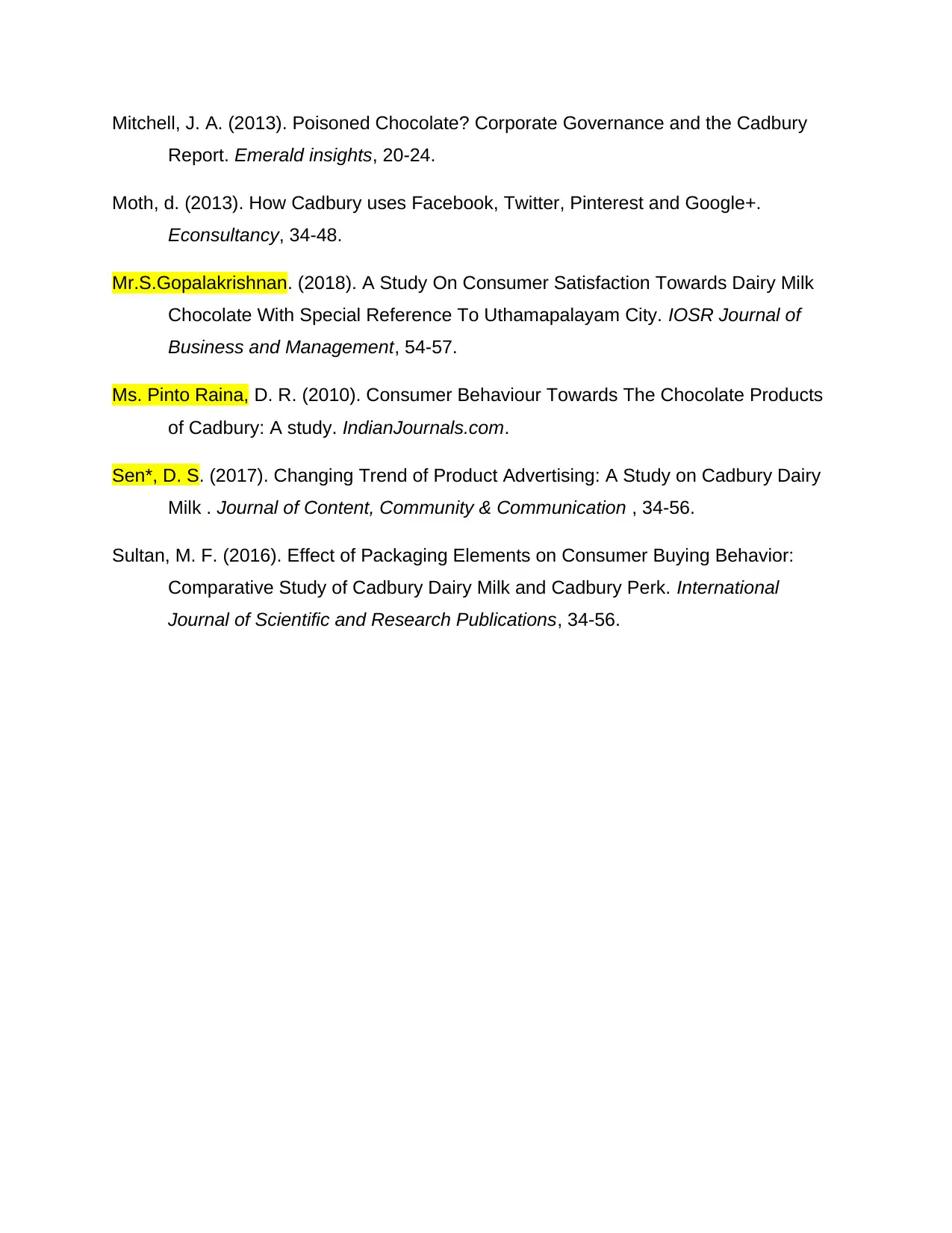
Mitchell, J. A. (2013). Poisoned Chocolate? Corporate Governance and the Cadbury
Report. Emerald insights, 20-24.
Moth, d. (2013). How Cadbury uses Facebook, Twitter, Pinterest and Google+.
Econsultancy, 34-48.
Mr.S.Gopalakrishnan. (2018). A Study On Consumer Satisfaction Towards Dairy Milk
Chocolate With Special Reference To Uthamapalayam City. IOSR Journal of
Business and Management, 54-57.
Ms. Pinto Raina, D. R. (2010). Consumer Behaviour Towards The Chocolate Products
of Cadbury: A study. IndianJournals.com.
Sen*, D. S. (2017). Changing Trend of Product Advertising: A Study on Cadbury Dairy
Milk . Journal of Content, Community & Communication , 34-56.
Sultan, M. F. (2016). Effect of Packaging Elements on Consumer Buying Behavior:
Comparative Study of Cadbury Dairy Milk and Cadbury Perk. International
Journal of Scientific and Research Publications, 34-56.
Report. Emerald insights, 20-24.
Moth, d. (2013). How Cadbury uses Facebook, Twitter, Pinterest and Google+.
Econsultancy, 34-48.
Mr.S.Gopalakrishnan. (2018). A Study On Consumer Satisfaction Towards Dairy Milk
Chocolate With Special Reference To Uthamapalayam City. IOSR Journal of
Business and Management, 54-57.
Ms. Pinto Raina, D. R. (2010). Consumer Behaviour Towards The Chocolate Products
of Cadbury: A study. IndianJournals.com.
Sen*, D. S. (2017). Changing Trend of Product Advertising: A Study on Cadbury Dairy
Milk . Journal of Content, Community & Communication , 34-56.
Sultan, M. F. (2016). Effect of Packaging Elements on Consumer Buying Behavior:
Comparative Study of Cadbury Dairy Milk and Cadbury Perk. International
Journal of Scientific and Research Publications, 34-56.
1 out of 10
Related Documents
Your All-in-One AI-Powered Toolkit for Academic Success.
+13062052269
info@desklib.com
Available 24*7 on WhatsApp / Email
![[object Object]](/_next/static/media/star-bottom.7253800d.svg)
Unlock your academic potential
Copyright © 2020–2025 A2Z Services. All Rights Reserved. Developed and managed by ZUCOL.





